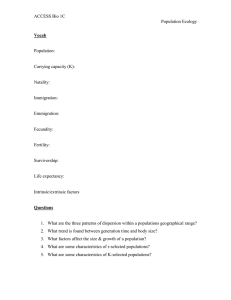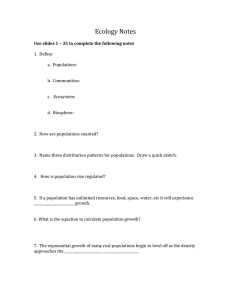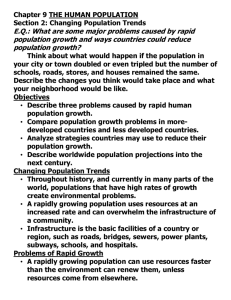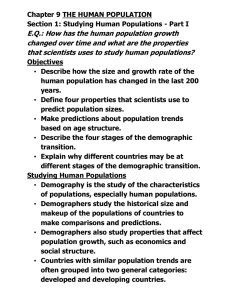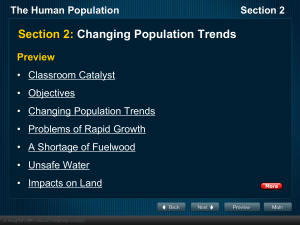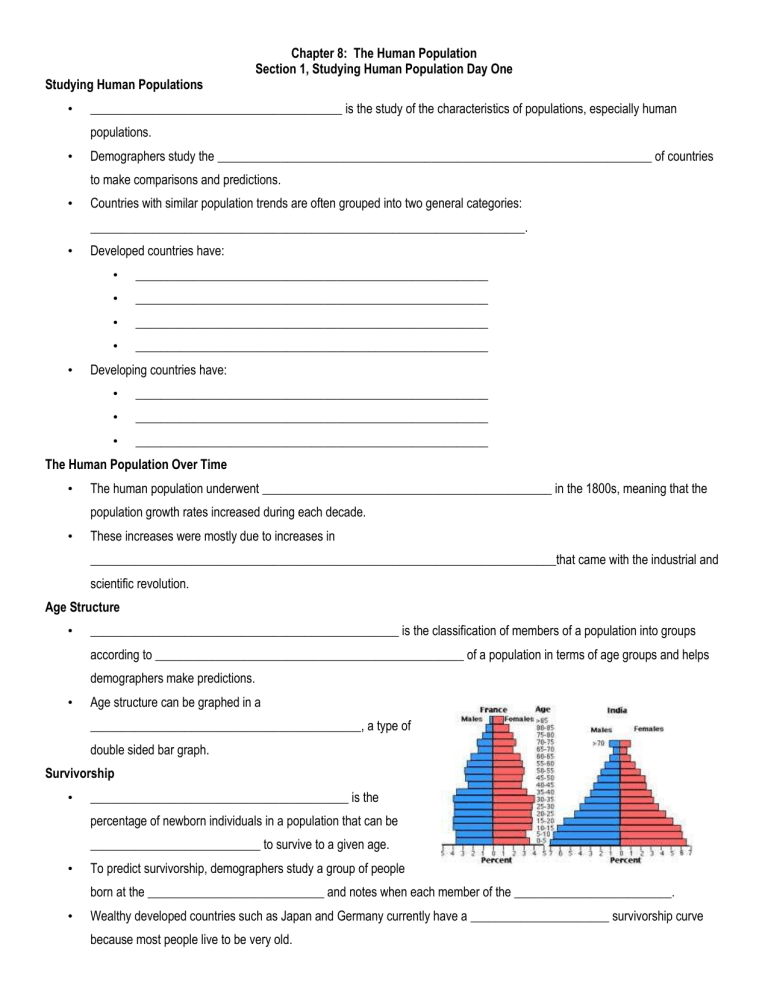
Studying Human Populations • Chapter 8: The Human Population Section 1, Studying Human Population Day One ________________________________________ is the study of the characteristics of populations, especially human populations. • Demographers study the _____________________________________________________________________ of countries to make comparisons and predictions. • Countries with similar population trends are often grouped into two general categories: _____________________________________________________________________. • • Developed countries have: • ________________________________________________________ • ________________________________________________________ • ________________________________________________________ • ________________________________________________________ Developing countries have: • ________________________________________________________ • ________________________________________________________ • ________________________________________________________ The Human Population Over Time • The human population underwent ______________________________________________ in the 1800s, meaning that the population growth rates increased during each decade. • These increases were mostly due to increases in __________________________________________________________________________that came with the industrial and scientific revolution. Age Structure • _________________________________________________ is the classification of members of a population into groups according to _________________________________________________ of a population in terms of age groups and helps demographers make predictions. • Age structure can be graphed in a ___________________________________________, a type of double sided bar graph. Survivorship • _________________________________________ is the percentage of newborn individuals in a population that can be ___________________________ to survive to a given age. • To predict survivorship, demographers study a group of people born at the ____________________________ and notes when each member of the _________________________. • Wealthy developed countries such as Japan and Germany currently have a ______________________ survivorship curve because most people live to be very old. • ______________________ populations have a similar death rate at all ages. • ______________________ survivorship is the pattern in very poor human populations in which many children die. • Both Type I and Type III may result in populations that remain the ___________________________________________________. Fertility Rates • A ___________________________________ is the number of births (usually per year) per 1,000 women of childbearing age (usually 15 to 44). • _______________________________________ is the average number of children each parent must have in order to “replace” themselves. • _______________________________________, the total fertility dropped below replacement level for the first time in US History. Migration • _______________________________________ in general, is any movement of individuals or populations from one location to another. • Movement into an area is ________________________ and movement out of an area is _____________________________________________. Declining Death Rates • Death rates have declined mainly because more people now have access to: • _____________________________________________________ • _____________________________________________________ • _____________________________________________________ • _____________________________________________________ Life Expectancy • ________________________________________________is the average length of time that an individual is expected to live. • Life expectancy is most affected by _____________________________________________, the death rate of infants less than a year old. The Demographic Transition • The _______________________________________ is the general pattern of demographic change from high birth and death rates to low birth and death rates, and observed in the history of more-developed countries. • The theory behind the demographic transition is that industrial development causes ___________________________________________ that then affects population growth rates. Stages of the Transition • In the first stage of the demographic transition, a society is in a __________________________________________________. • The birth rate and the death rate are both at ___________________________ and the population size is _______________________________. • In the second stage, a ____________________________________ occurs. • Death rates _______________________________ as hygiene, nutrition, and education improve. • In the third stage, population growth _________________________ because birth rate decreases. • • As the birth rate becomes close to the death rate, the population size ___________________________________. In the fourth stage, the birth rate drops _____________________________________________, so the size of the population begins to decrease. Women and Fertility • The factors most clearly related to a decline in birth rates are ____________________________ education and economic independence for women. Chapter 8: The Human Population Section 2, Changing Population Trends Day Two Changing Population Trends • Throughout history, and currently in many parts of the world, populations that have high rates of growth create _______________________________________________________. • _________________________________________ is the basic facilities of a country or region, such as roads, bridges, sewers, power plants, subways, schools, and hospitals. Problems of Rapid Growth • A rapidly growing population can use resources faster than the environment can renew them, unless resources come from elsewhere. • Symptoms of overwhelming populations include __________________________________________________________________________________________. A Shortage of Fuelwood • In many of the poorest countries, _______________________ is the main fuel source. • When populations are stable, people use fallen tree limbs for fuel. When populations grow rapidly, _____________________________does not accumulate fast enough to provide enough fuel. Unsafe Water • In places that lack infrastructure, the local water supply may be used not only for drinking and washing but also for _________________________________________. • As a result, the water supply becomes a breeding ground for organisms that can cause diseases such as ______________________________________________________________________________. Impacts on Land • Growing populations may have a shortage of arable land. • ______________________________________ is farmland that can be used to grow crops. • ______________________________________ is an increase in the ratio or density of people living in urban areas rather than in rural areas. A Demographically Diverse World • _____________________________________________________ are countries that have been identified by the United Nations as showing the fewest signs of development in terms of income, human resources, and economic diversity. • These countries may be ______________________________________________ for foreign aid and development programs to address their population and environmental problems. Managing Development and Population Growth • Today, less developed countries face the likelihood that continued population growth will ___________________ them from imitating the development of the world’s economic leaders. • These campaigns include ___________________________________________________________________________________________. • Many countries favor stabilizing population growth through investments in _______________________________, especially through improvements in women’s status. Growth Is Slowing • Fertility rates have ________________________________ in both more-developed and less-developed regions. • If current trends continue, most countries will have __________________________________ fertility rates by 2050. If so, world population growth would eventually stop. Projections to 2050 • Looking at the graph below, most demographers predict the medium growth rate, and a world population of_____________________________________________ in 2050.


